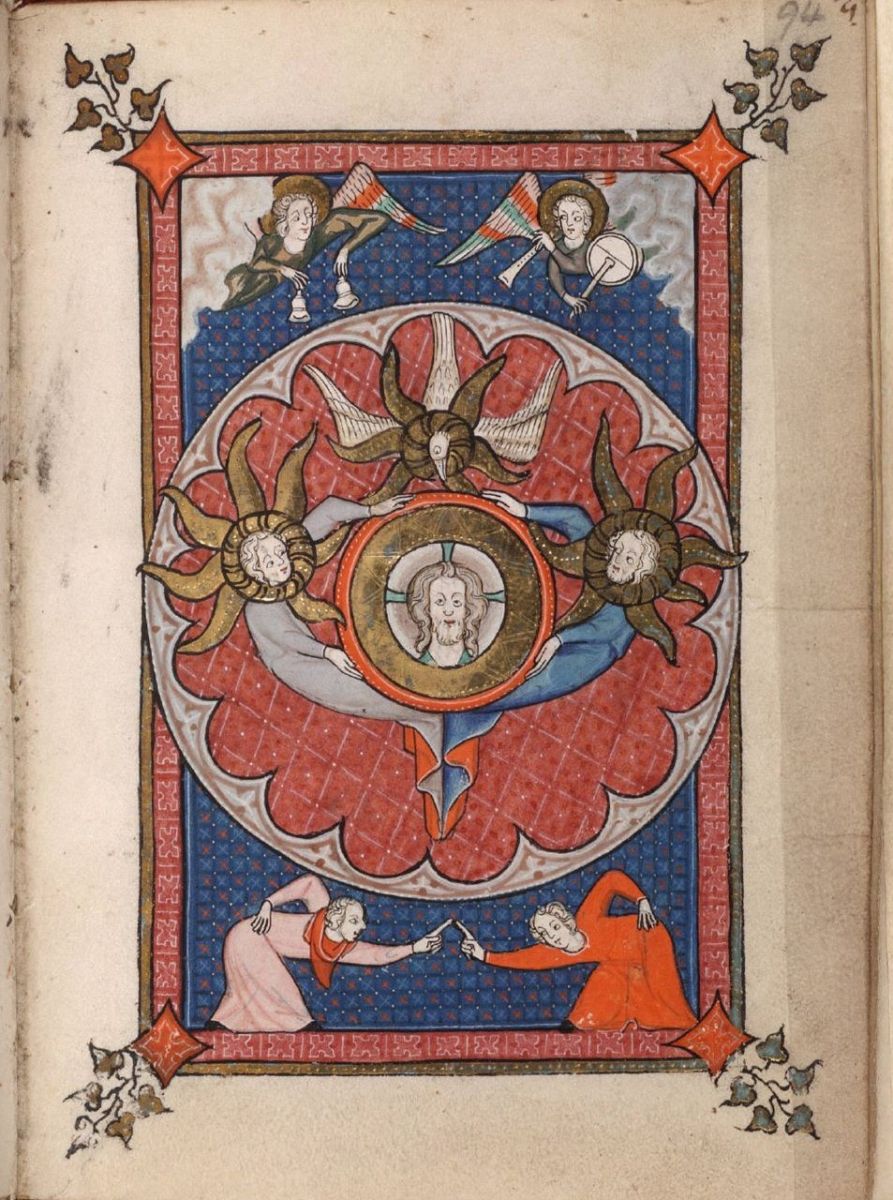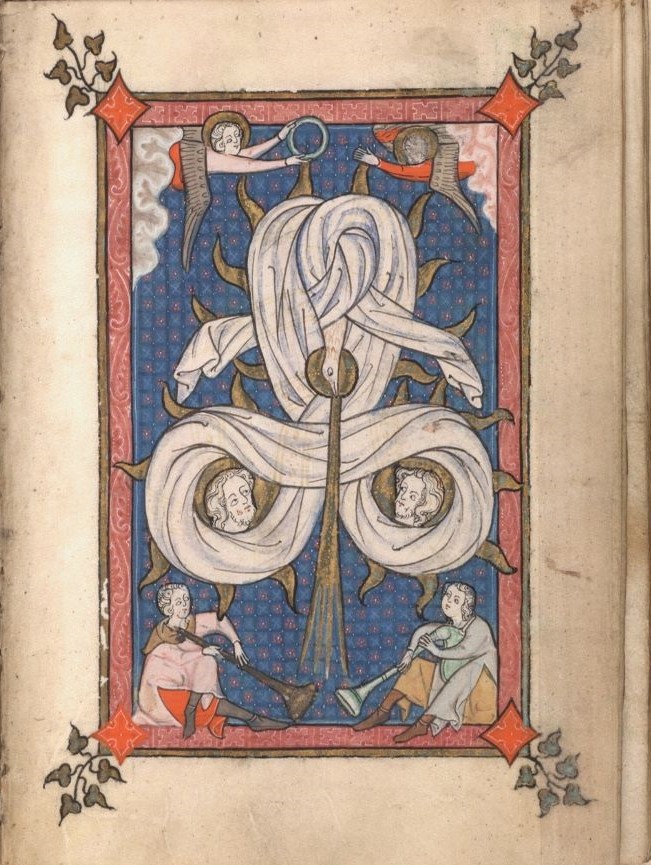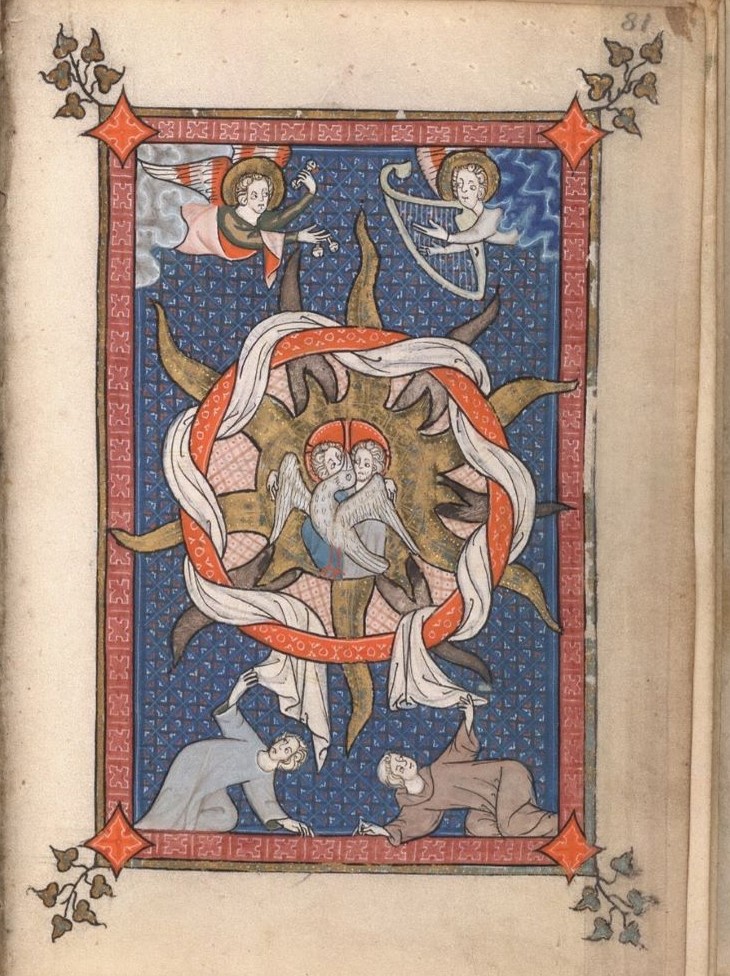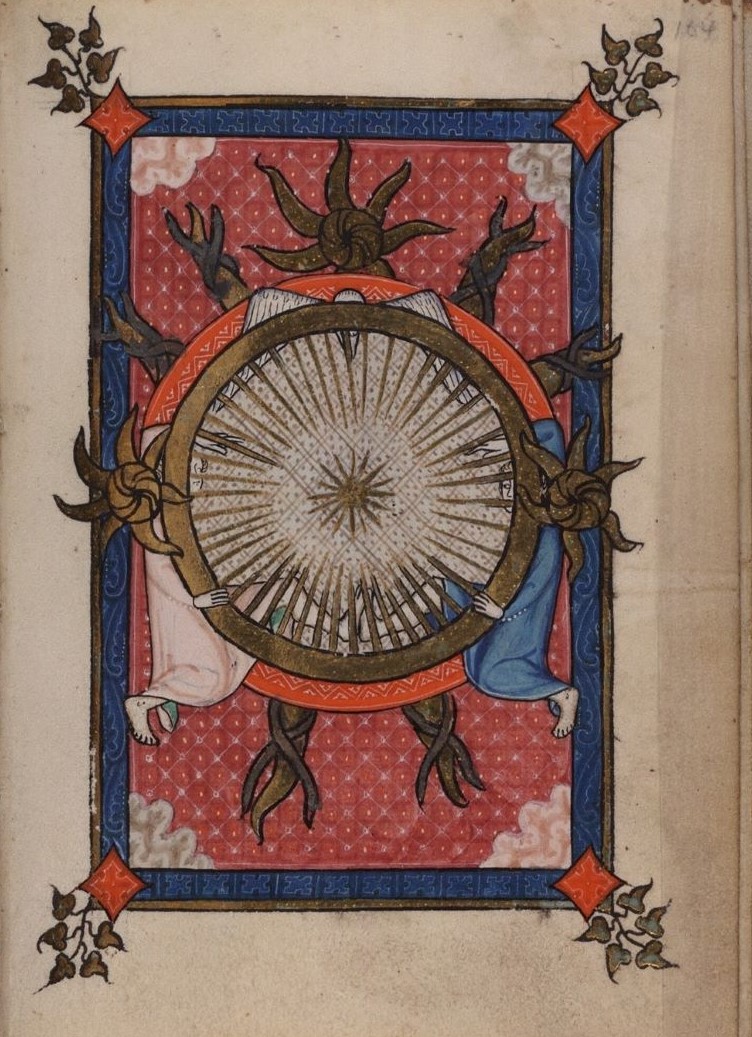Rothschild Canticles - VM - Victoria Emily Jones
Trinity Miniatures from the Rothschild Canticles

The Wheeling Playfulness of the Trinity
by Victoria Emily Jones
June 4 is Trinity Sunday, a moveable feast dedicated to celebrating the Christian mystery of the Three-in-One. Words and images can only really gesture toward, never fully explain or capture, this paradox. Still, there is value in meditating on it, as the Triune nature of God gives us a glimpse into who God is. Augustine, who wrote a book-length treatise on the Trinity, expresses this caution and encouragement at its outset: “in no other subject is error more dangerous, or inquiry more laborious, or the discovery of truth more profitable” (De Trinitate I.iii.5).
Some of the most innovative visual imaginings of the Trinity come from a small handheld devotional book from early fourteenth-century Flanders or the Rhineland called the Rothschild Canticles. Made for a nun, the book compiles Bible verses, liturgical praises, and theological and exegetical material, along with forty-six full-page miniatures—an unprecedented nineteen of which are on the subject of the Trinity,* all full of whimsy, warmth, and joy. Much of the text that accompanies this sequence is taken from Augustine’s On the Trinity.
In contrast to other depictions of the Trinity, in the Rothschild Canticles we find, says medievalist Barbara Newman,
a playful, intimate approach to the triune God, marked by spontaneity rather than solemnity, dynamism rather than hieratic stasis, wit rather than awe. There is no hint of narrative, but something more like an eternal dance. . . . The divine persons are caught up in an everlasting game of hide-and-seek with humans while they enact among themselves, in ever-changing ways, that mutual coinherence that the Greek fathers called perichoresis—literally “dancing around one another.” (Newman 135)
Art historian Jeffrey Hamburger says that turning the pages of the Trinitarian section is like turning a kaleidoscope, with clouds, suns, and veils “combin[ing] and recombin[ing] in an apparently endless series of transformations,” most set within a circular matrix (Hamburger 128).
On folio 94r (pictured above), the three persons of the Trinity are enclosed in a circular frame and surround a central face that represents the one Divine Essence. Each wears a sun as a collar, a charming artistic choice perhaps inspired by Psalm 104:2, which says the Lord is “clothed in light as with a garment.” Angels ring bells, beat a drum, blow into a reed, while two humans dance to the music. The accompanying liturgical verse translates from the Latin to “He saw three and worshipped one,” referring to the theophany at Mamre, where Abraham saw three men, fell down in worship, and then addressed his divine visitors in the singular (Genesis 18:1–3).

Folio 84r
Play continues on folio 84r, where the three persons
are embedded in a long winding sheet, a triangular interlaced textile forming three connected loops. The loose ends ingeniously suggest the wings of a dove. A stream of light pours forth from the beak of the dove toward the two musicians seated at the bottom. Behind the cloth, the flares of three suns lock the persons together like the teeth of so many cogwheels. (Hamburger 135)
The angels above appear to be playing ring toss!

Folio 81r
Cloth shows up in several of the images—sometimes concealing, sometimes revealing, sometimes both. On folio 81r it is braided around a circular band that frames the Trinity, twisting over and under the sunrays emanating from the center. The Trinity is depicted as two anthropomorphized figures and a dove nestled together in an embrace and sharing a nimbus. Hamburger cites a handful of (contemporary) Middle High German devotional poems that use metaphors of braiding, knitting, tying, or weaving to describe the Trinity in its inseparability—for example, “three Persons braided and pressed into one God” or the “three Persons of God, tied into a single strand of Being” (Hamburger 139).
Augustine speaks of the Holy Spirit as personified Love, uniting Father and Son. The Rothschild compiler, who may have designed the miniatures, harks to this idea by adapting Ephesians 2:14 on folio 80v, writing that the Holy Spirit “makes both [Father and Son] one.”
Also quoted on the facing page is the story of the woman in need of healing who touches the hem of Jesus’s garment (Matthew 9:20–22). The artist alludes to the story by placing two kneeling figures at the bottom, each reaching out to touch an edge of the veil that dangles just within reach, signifying divine power.

Folio 104r
God’s hiddenness, his incomprehensibility, is one of the recurring themes in the Rothschild Trinity miniatures. Take folio 104r for example, the penultimate image in the sequence. Father, Son, and Holy Spirit are partially hidden behind a wheel that they turn round and round, the former two touching each other’s bare feet to brace themselves up! The sun has imploded. The text opposite the image states, in God’s voice, “My center is in all places, my circumference nowhere”—a popular medieval axiom to express how God is all-encompassing and cannot be circumscribed.
*******
* The original manuscript had fifty miniatures, including twenty on the Trinity, but some of these are now lost.
Miniatures from the Rothschild Canticles (MS 404), Flanders or Rhineland, ca. 1300. Illuminations on parchment, each page 11.8 × 8.4 cm. Beinecke Rare Book and Manuscript Library, Yale University, New Haven, Connecticut. View the digitized manuscript, and see the Art & Theology blog post “Innovative Trinity paintings from the Rothschild Canticles.”
Victoria Emily Jones lives in the Baltimore area of the United States, where she works as an editorial freelancer and blogs at ArtandTheology.org, exploring ways in which the arts can stimulate renewed engagement with the Bible. She serves on the board of the faith-based arts nonprofit the Eliot Society and as art curator for the Daily Prayer Project, and she has contributed to the Visual Commentary on Scripture and the Encyclopedia of the Bible and Its Reception. Follow her on Instagram @art_and_theology.
WORKS CITED
Hamburger, Jeffrey F. The Rothschild Canticles: Art and Mysticism in Flanders and the Rhineland circa 1300. New Haven and London: Yale University Press, 1990.
Newman, Barbara. “Contemplating the Trinity: Text, Image, and the Origins of the Rothschild Canticles.” Gesta 52, no. 2 (September 2013): 133–59.
ArtWay Visual Meditation 4 June 2023


